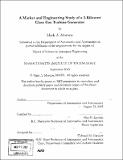| dc.contributor.advisor | Alan H. Epstein. | en_US |
| dc.contributor.author | Monroe, Mark A. (Mark Alan) | en_US |
| dc.contributor.other | Massachusetts Institute of Technology. Dept. of Aeronautics and Astronautics. | en_US |
| dc.date.accessioned | 2008-09-03T14:52:28Z | |
| dc.date.available | 2008-09-03T14:52:28Z | |
| dc.date.copyright | 2003 | en_US |
| dc.date.issued | 2003 | en_US |
| dc.identifier.uri | http://hdl.handle.net/1721.1/42200 | |
| dc.description | Thesis (S.M.)--Massachusetts Institute of Technology, Dept. of Aeronautics and Astronautics, 2003. | en_US |
| dc.description | Includes bibliographical references (p. 147-149). | en_US |
| dc.description.abstract | Market and engineering studies were performed for the world's only commercially available 3 kW class gas turbine generator, the IHI Aerospace Dynajet. The objectives of the market study were to determine the competitive requirements for small generators in various U.S. applications, assess the unit's current suitability for these applications, and recommend ways to modify performance or marketing practices to make it more competitive. Engineering study goals included developing an accurate cycle model and assessing the potential for performance improvement. The market study found that the current high selling price precludes competitiveness in most segments of the U.S. civil market. One potential exception may be the marine market, where price sensitivity is less of an issue and a premium is paid for quiet operation, a distinct advantage of the Dynajet. A gas turbine generator solution has more potential in the military market, where the difference from incumbent prices is smaller than in the civil market. The Dynajet is also an appealing military solution because of its high reliability and quiet operation. The market study concluded that increasing power output and efficiency while reducing purchase price would be the most effective approach to improved competitiveness. Alternatively, the current strengths could be leveraged by adapting it for use with an absorption cooler and by emphasizing its superior emission characteristics to consumers and regulators. The engineering study discovered that cycle performance is degraded by secondary nonidealities including flow leakage, heat leakage, and thermal flow distortion. Although these nonidealities are present to some degree in all gas turbines, their impacts are larger in small-scale engines. | en_US |
| dc.description.abstract | (cont.) The net effect of all nonidealities is a 61 percent reduction in power and 12 point decrease in overall efficiency. Analysis concluded that the best way to enhance Dynajet competitiveness is to reduce or remove those nonidealities that are straightforward to fix while increasing power output to either 3 or 5 kW. Output of 5 kW is most promising in terms of cost and weight competitiveness; however, such an improvement may require turbomachinery redesign. A short-term increase of power output to 3 kW appears practical from an engineering standpoint. | en_US |
| dc.description.statementofresponsibility | by Mark A. Monroe. | en_US |
| dc.format.extent | 149 p. | en_US |
| dc.language.iso | eng | en_US |
| dc.publisher | Massachusetts Institute of Technology | en_US |
| dc.rights | M.I.T. theses are protected by
copyright. They may be viewed from this source for any purpose, but
reproduction or distribution in any format is prohibited without written
permission. See provided URL for inquiries about permission. | en_US |
| dc.rights.uri | http://dspace.mit.edu/handle/1721.1/7582 | en_US |
| dc.subject | Aeronautics and Astronautics. | en_US |
| dc.title | A market and engineering study of a 3-kilowatt class gas turbine generator | en_US |
| dc.type | Thesis | en_US |
| dc.description.degree | S.M. | en_US |
| dc.contributor.department | Massachusetts Institute of Technology. Department of Aeronautics and Astronautics | |
| dc.identifier.oclc | 230817676 | en_US |
